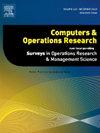Optimal placement of electric vehicle slow-charging stations: A continuous facility location problem under uncertainty
IF 4.3
2区 工程技术
Q2 COMPUTER SCIENCE, INTERDISCIPLINARY APPLICATIONS
引用次数: 0
Abstract
Electric vehicles (EVs) are becoming a key mechanism to reduce emissions in the transportation industry, and hence contribute to the green transition. In this paper, we present a mathematical programming model which determines the optimal placement of EV charging stations such that chargers are placed in the most cost-efficient way possible for all stakeholders, assuming additionally that EV charging demand is inherently stochastic in nature. The model is formulated as a two-stage, continuous location–allocation model in the form of a generalised Weber problem in two dimensions. However, this formulation is non-convex and notoriously difficult to solve. We therefore propose a suitable discretisation procedure to find high quality solutions in suitable time. The discretisation procedure shows strong performance across a variety of computational experiments using randomly generated scenarios, maintaining robustness in terms of the objective value and overall solution quality.
A part of this solution procedure was entered into the 15th AIMMS-MOPTA Optimisation Modelling Competition.
电动汽车慢充电站优化布局:不确定条件下的连续设施选址问题
电动汽车(ev)正在成为交通运输行业减少排放的关键机制,从而有助于绿色转型。在本文中,我们提出了一个数学规划模型,该模型确定了电动汽车充电站的最佳布局,使充电器以最具成本效益的方式放置,并假设电动汽车充电需求本质上是随机的。该模型以二维广义韦伯问题的形式表述为一个两阶段、连续的位置分配模型。然而,这个公式是非凸的,很难求解。因此,我们提出了一个合适的离散化程序,以在合适的时间内找到高质量的解决方案。离散化过程在使用随机生成的场景的各种计算实验中显示出强大的性能,在客观值和整体解决方案质量方面保持鲁棒性。这个解决方案的一部分进入了第15届AIMMS-MOPTA优化建模比赛。
本文章由计算机程序翻译,如有差异,请以英文原文为准。
求助全文
约1分钟内获得全文
求助全文
来源期刊

Computers & Operations Research
工程技术-工程:工业
CiteScore
8.60
自引率
8.70%
发文量
292
审稿时长
8.5 months
期刊介绍:
Operations research and computers meet in a large number of scientific fields, many of which are of vital current concern to our troubled society. These include, among others, ecology, transportation, safety, reliability, urban planning, economics, inventory control, investment strategy and logistics (including reverse logistics). Computers & Operations Research provides an international forum for the application of computers and operations research techniques to problems in these and related fields.
 求助内容:
求助内容: 应助结果提醒方式:
应助结果提醒方式:


